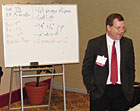
Matt Stevens, president of Stevens Construction Institute,
Inc., stands next to a description of the “bridge project,” part of his seminar
at the Florida Refrigeration and Air Conditioning Contractor’s Association (FRAACA)
annual conference in Orlando.
Stevens backed up his comments by conducting an exercise involving FRACCA members who “bid” on a construction project during the seminar. Before the exercise, he talked about the various components of a project, including:
•Productive time:Time spent putting work in place right the first time.
•Planning time:Time spent planning and organizing the work.
•Wasted time:Time spent that is neither planning time nor productive time. “This might include waiting for materials or instructions/information to arrive,” Stevens said.
Planning time is critical because it is so universal across all trades, he noted. “First of all, you have to define planning,” Stevens said. “You don’t just give someone a legal pad and tell them to plan a project out. There are correct ways to plan.
“It can be as simple as having the jobs listed on sticky notes and then organizing them into a plan.”
Stevens said it is important for someone within a company to know or have access to information on all of the existing jobs. He said the president or owner usually knows this information and added, “Someone should be able to estimate what the jobs will look like and should also know what labor is available for new projects.”
Stevens stated a tip that makes the planning process more efficient; especially when participants in the planning don’t all speak the same language. “Using graphics is very important in planning,” he said. “There are no language barriers in graphics.”

FRACCA members formed a team to complete a “bridge project”
as part of an exercise in productivity, developed by Stevens.
BUILDING THE BRIDGE
Stevens used a bridge-building project to show the importance of planning and the critical issue of wasted time, which he said makes up 32 percent of total project time. He divided the audience into four groups. Each was asked to name their group and bid out the project based on the estimated time to complete the construction of the bridge, which consisted of 63 PVC tubes in various shapes - and included two pieces that didn’t fit anywhere on the bridge.Each group submitted their bids, with the help of some guidelines set up by Stevens. Each group was allowed to choose the size of their construction crew, too. The sealed bids ranged from estimates of 3:45 to 5 minutes to complete the bridge construction. Stevens chose the team with the 3:45 estimate.
The three-person crew completed the bridge in 3:15, making it unnecessary to pass the project on to the next shortest time bidder. During the task, Stevens asked the other groups to write down observations about planning, production, and wasted time.
The winning group used one person to instruct two other workers as they assembled the bridge. The exercise, according to Stevens, resulted in several common observations:
• Pre-job planning;
• Material handling and layout;
• Safety/cleanliness of jobsite;
• Crew size;
• Rework;
• Communication/teamwork;
• Work pace/sense of urgency.
In the years he has demonstrated this exercise, the fastest time has been 2:30 minutes and the slowest was 7 minutes, “before the crew finally gave up,” Stevens said.
For more information, visit www.stevensci.com.
Publication date:05/19/2008

Report Abusive Comment